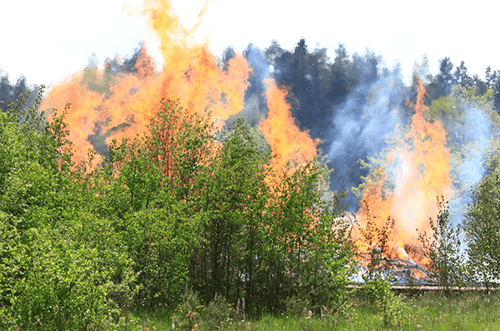Wildfire Smoke: Impact on Air Quality and Health

The 2023 Canadian wildfires have had a significant impact on air quality across North America this summer. Wildfire smoke can have serious repercussions on the environment and individuals living in affected areas. While the recent wildfires have been taxing on air quality particularly this summer, being prepared for wildfires at any time is a healthy practice.
Impact on Air Quality
Wildfires release large amounts of smoke, which can significantly affect the air we breathe. As the smoke travels, it can cover vast areas, leading to substantial degradation of air quality in the burn area and beyond. The enormous amount of smoke and pollutants released during wildfires increases the concentration of harmful particles in the air called particulate matter. This can pose serious health risks, especially for individuals with pre-existing lung conditions.
Additionally, these particles can remain suspended in the atmosphere for an extended period of time, leading to poor visibility, the formation of smog, and reduced sunlight reaching the ground. The Air Quality Index (AQI) is used to measure when air pollution may have an impact on your health.
If you find yourself particularly close to a wildfire, carbon monoxide poisoning is a real danger as well. Firefighters are generally more at-risk for carbon monoxide poisoning from the actual wildfire due to their close proximity to the smoke, however, carbon monoxide exposure is always a risk if you find yourself in an enclosed area with smoke.
Additionally, if your area experiences widespread power outages as a result of a nearby wildfire, carbon monoxide poisoning can occur because people will need to find alternate cooking and heating options (such as a gas grill) and may do so unsafely indoors to keep from breathing in the smoke outdoors. Loss of electricity could also affect a carbon monoxide detector’s power supply.
Health Risks
Breathing in smoke and pollutants from wildfires can have severe health implications, particularly for the elderly, young children, and individuals with pre-existing lung conditions such as asthma, bronchitis, and COPD. Exposure to smoke can cause irritation of the eyes, nose, and throat. Most concerning is the irritation it can cause to the lungs, leading to coughing, wheezing, and in severe cases difficulty breathing. Prolonged exposure to the smoke can also increase the risk of heart attacks, stroke, and other cardiovascular problems.
Wildfire smoke contains carbon monoxide. Carbon monoxide is an odorless gas that affects the way oxygen is carried to body tissues and vital organs. The CDC advises how important it is to prevent carbon monoxide poisoning after an emergency.
Beyond health risks associated with the smoke itself, there are myriad other issues wildfires cause. For example, wildfires can cause water supply contamination through the release of toxins, ash, and sediment runoff. This contamination poses risks to communities that rely on those water sources for drinking, irrigation, and other purposes. The loss of vegetation due to wildfires leaves the soil exposed, making it vulnerable to soil erosion by wind and rain. This erosion can lead to land degradation and affect water quality as sediments enter rivers and other water bodies.
Recovering from the scars left by wildfires is a slow and complex process for affected forests. The loss of mature trees disrupts the natural regeneration of forests, hindering their capacity to provide crucial services like carbon sequestration and habitat support.
Precautions to Take
When facing the impact of wildfires on air quality, it is crucial to take necessary precautions to protect yourself and your family’s health. Here are three key steps to consider:
- Stay Informed: Stay updated on the air quality index in your area by monitoring local weather stations, environmental agencies such as AirNow.gov (home of the U.S. Air Quality Index), official websites, and health advisories. This information will help you make informed decisions about outdoor activities and potential exposure risks.
- Limit Outdoor Activities: It is advisable to reduce physical exertion and limit outdoor activities, especially during periods of poor air quality. If you must go outside, wearing a mask specifically designed to filter smoke particles (e.g., N95 or P100 respirators) can be effective in reducing smoke inhalation. Make sure to wear them properly, covering both your nose and mouth.
- Maintain Indoor Air Quality: Consider using air purifiers or filters with HEPA technology to improve indoor air quality. It is also essential to minimize the use of products that release pollutants into the air, such as smoking, burning candles, or using certain cleaning chemicals.
Poison Centers Are Here for You
It is imperative to understand the potential health risks associated with smoke inhalation and take necessary precautions to protect ourselves during such events. By staying informed, limiting outdoor activities, and maintaining indoor air quality, we can mitigate some of the harmful effects of wildfires on our well-being.